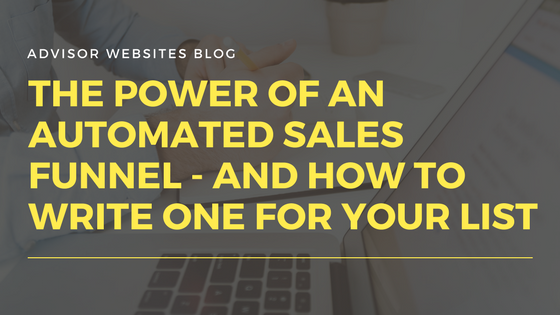You’ve heard about the power of email lists to grow your advisory practice, but that power isn’t just in owning a static list of email addresses. You’ll need to engage regularly with people on your list, and introduce them to how your business can improve their lives by solving pressing problems for them.
The best, and easiest, way to do that is to build an automated sales funnel for your list.
What is an automated sales funnel?
An automated sales funnel is a series of emails that gets sent out automatically to anyone who joins your email list. It’s designed to turn leads into customers by walking them through common phases in the sales process, but it happens automatically - as opposed to in a first meeting with prospects.
When properly set up, it can help deliver pre-qualified new meetings to your practice on autopilot.
Most email service providers will let you set up an automated email sequence that will send out on a schedule, triggered when someone joins your list. You’ll want to get that tech set up in place so you don’t end up creating even more work for yourself by manually sending out every email!
How do I figure out what to include?
To build a great sales funnel, think about your audience first.
Consider where they are when they’re first connecting with you.
- Are they ready to work with an advisor?
- Are they evaluating options?
- Do they even know what you do?
- What problems do they need solved?
- Do they understand why they need what you have to offer?
Once you’ve got a list of those answers, you’re ready to start building out your sales funnel, informed by what you know about your audience.
Start with your opt-in incentive
If you don’t have an opt-in incentive, you need one. It’s rare that someone will hand over their email address to “join a newsletter” these days, so you’ll need to offer them something to start the process and get them onto your list.
Check out our whitepapers to figure out what’s a good fit, and what would entice someone to join your email list - and get into your sales funnel.
Introduce yourself and your business
After you’ve delivered the opt-in incentive, you should wait a day or two, and follow up with an introduction to your business.
Consider including specifics about who you help in that email - and although it can feel risky, it can be helpful to include who you don’t help as well.
The only reason to have people on your list is to help them connect with you and become clients, so if you only work with people who have a certain portfolio size, or you specialize in a specific field? Don’t be shy to be clear about that in your introductory emails.
It’ll help people self-select, and it’ll reduce the number of meetings you take with people who aren’t a fit for your business.
Deliver value
The next few emails in your sequence should focus on delivering value. How can you help people solve common problems, or overcome challenges, with a bit of email guidance?
Maybe you can send them helpful evergreen blog posts, or write specific content for each email to help with common problems that they can tackle. This could be anything from cutting down their grocery bills, all the way to figuring out how much life insurance they need.
As long as it’s relevant and helpful to your ideal client, it’s a good touchpoint with them.
Overcome objections
You can also use this email sequence to overcome objections.
What are some common misconceptions you hear about why people don’t want to work with financial advisors? Or what are some things people think that just aren’t true?
At least one email in your sequence should help readers overcome a traditional sales objection. Think about the “Buts” you hear in first conversations with prospective clients. “But can we afford planning?” “But how will it help us long-term?”
Create engagement
When you’re building your sales funnel, don’t be afraid to write the way you’d speak to people in person.
You can ask questions and ask for replies to your emails, and you could even include other ways of connecting with you, whether it’s social media or taking a survey. Asking people to engage with you beyond just opening an email is a great way to slowly build a connection with them.
Ask for the sale
Finally, at one (or more!) point in the sales funnel, you’ll want to ask for the sale.
It doesn’t have to be as bold as “Work with me now.” You can use a soft sell approach by mentioning your services in context, but you should aim for at least one soft sell and at least one hard sell in the sequence.
Finally, keep tabs on your sales funnel
Last but certainly not least, you’ll want to keep track of how your sales funnel is performing. Take a look at things like your email open rates, click-through rates and how many meetings are requested through those emails.
You can always tweak the emails, the timing, or both if your automated sales funnel isn’t delivering the results you want.

.jpeg)




.png)

